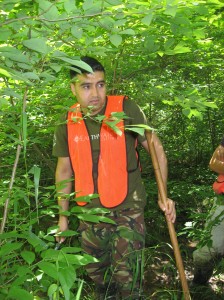by Kristen Minogue

Ali Kishwar, a volunteer tourist from Pakistan, navigates the muddy terrain across from SERC’s beaver pond with caution. (Credit: SERC)
For most people, summer vacation means stretching out on a beach in the South Pacific, touring the ruins of ancient Greece, or (for the more outdoors-inclined) hiking the Inca Trail in Peru. It does not usually entail wading through ankle-deep mud to measure the diameters of trees.
Paul Smith, a 63-year-old retired engineer, travelled to SERC all the way from the United Kingdom to do it. So did Ali Kishwar, a Pakistani doctorate student who took a break from studying medicinal plants at the University of Reading in Berkshire, also in the U.K. Smith and Kishwar joined a motley group of seven citizen scientists who paid to spend a week at SERC doing field work.
The project falls under the umbrella of Earthwatch Institute, a nonprofit that recruits nonscientists to do the sort of work labs would normally hire interns or postdocs to do. The work is just as varied as the people doing it. Earthwatch projects include everything from tagging sea turtles in Costa Rica to excavating Roman villas. In this case, the seven signed up to help SERC ecologist Jess Parker and his team complete a 5-year census of the different trees on campus.
It sounded tame on the surface. Lyman Davenport, who spent a previous Earthwatch trip searching for tiny mysid shrimp off the coast of Canada, said he thought plants would be a refreshing change. “They’re big enough to see…and they don’t move. You can sit there and find them.”
However, these trees happened to be sitting in a marsh where the mud was so thick, a single step turned into a balancing act. Each time a hiker raised a foot, the ground made romantic smacking sounds as it tried to suck the rubber boot back beneath the muck. More than one person fell. At least one boot came off in the process. There were times it was, in the most literal sense, a tourist trap.
But most didn’t find the mud intimidating. Some, like 23-year-old Emily Stechmann, almost considered it a perk. “I was kind of excited about it, especially when they first showed me the boots,” said Stechmann. “I felt like I was invincible.”
Their 5-day mission, combined with dozens of similar projects across the globe, makes up the largest field experiment on forests and climate change in the world. Its purpose: Find out how much carbon the forest can store, and how much of it is sent back to the atmosphere as it decays.
While alive, trees remove CO2 from the atmosphere during photosynthesis and store it as carbon. When their leaves fall to the ground and rot, they spit it back into the air. By measuring a tree’s diameter, scientists can calculate the size of its “carbon stock” (how much carbon it stores). By observing how the leaves decompose, they can figure out how fast the dead tree matter is releasing CO2 back into the atmosphere. The scientists at SERC are also measuring a variety of other variables, such as rainfall, CO2 concentrations and tree growth, to understand how forests are changing with climate.
SERC and Earthwatch have partnered to create the North America Regional Climate Center through funding from HSBC bank. The HSBC Climate Partnership is a 5-year program to inspire action by individuals, businesses and governments on climate change. They’re doing a 5-year census of the trees wider than 1 cm in a 16-hectare plot belonging to the Smithsonian Institute’s Global Earth Observatory (SIGEO). The project is also measuring trees in eight additional Earthwatch plots once every two years, which are specifically examining the interaction of forest management and climate change.
Smith, Kishwar and the other five volunteers arrived for the tail end of the first 5-year census. Once the data is collected, ecologists like Parker will combine it with data from more than 80 plots all over the world. It’s a daunting task, both in terms of synthesizing all the data and the countless hours that go into gathering it.
Then again, it always helps having people so avid about science, they’ll spend money to come do the dirty work.

